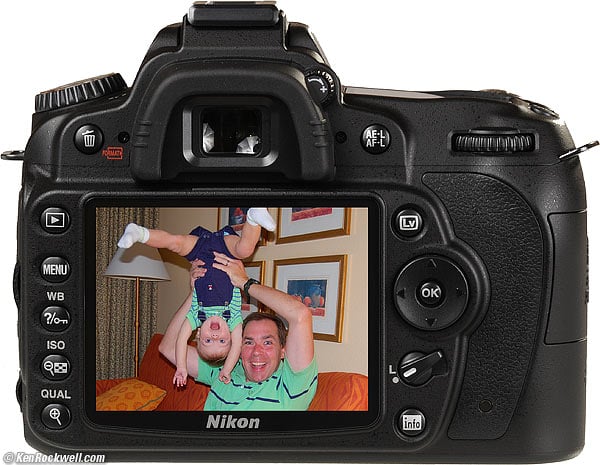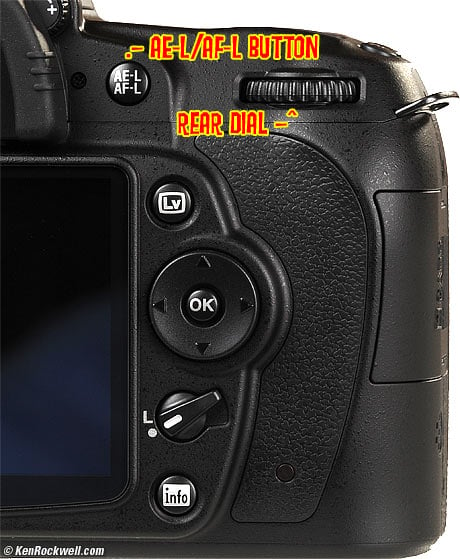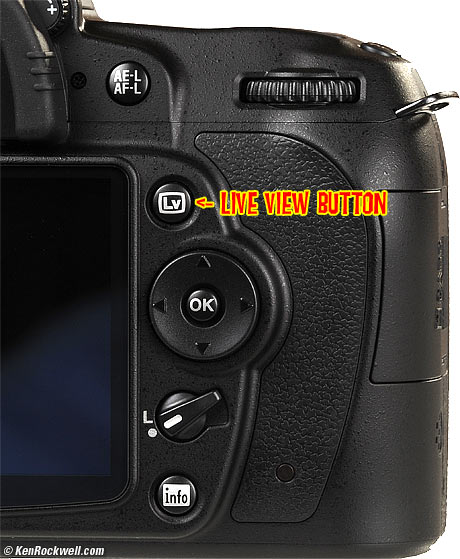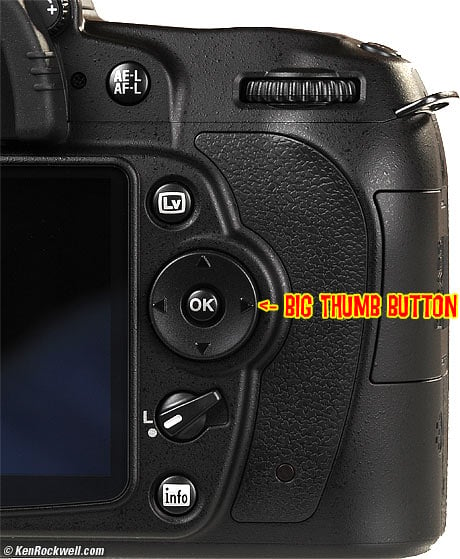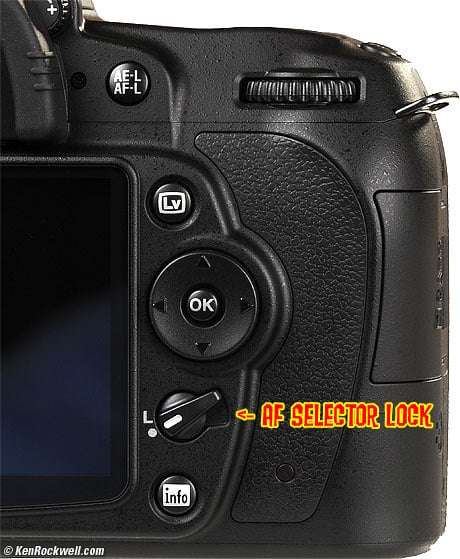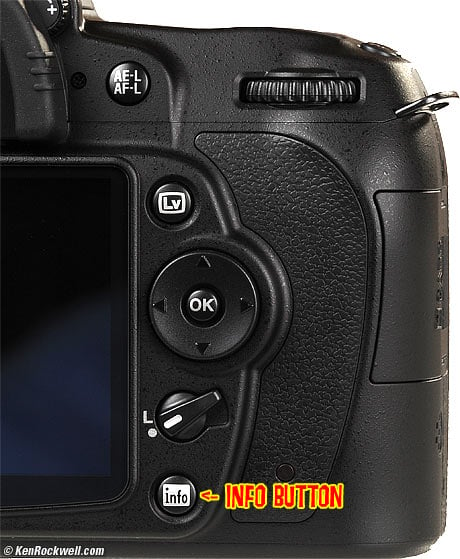Home Donate New Search Gallery How-To Books Links Workshops About Contact
Nikon
D90 User's Guide:
Rear Controls
© 2008 KenRockwell.com. All rights reserved.

Nikon D90 rear. enlarge.
September 2008 Top of D90 Users Guide D90 Review More Nikon Reviews
NEW: Nikon D90 iPod and iPhone App.
Want free live phone support? In the USA, call (800) NIKON-UX, 24 hours a day, 365 days a year.
Left side, top to bottom:
Trash (also doubles as one of the two FORMAT buttons) top
With an image on the LCD, press once. You'll get an "Are you sure?" message. Press again and the shot's gone. The D90 ignores this button if it's not playing back.
Hold this along with its brother (the MODE button) to format a memory card.
Play [>] Button top
Press it to see your pictures. Press again to turn them off.
MENU top
This gets you inside your D90.
I'll cover what you can screw up with this in the 11 long pages that follow.
?/Key/WB top
While in Menus: "?." Press for more information about whatever you're setting, if you see a gray "?" on the lower left of the color LCD. If no gray "?," then there is no help available.
The "?" button will eliminate your need to read half of this user's guide, if you need explanations of various menu options.
While in Playback: "Key." It protects (locks) the image from erasure.
Warning 1.): It marks the file so well that it won't empty out of my trash on my computer unless I go in and remark the file on my computer first!
Warning 2.): These images are erased from your memory card when you format anyway. Now you see why I don't use the lock feature.
While Shooting:
White Balance (WB) top
This is critical to getting the photos you want right out of your D90.
Spin the rear knob for broad changes. Spin the front knob to fine tune. See my White Balance Examples page and my White Balance page for the specifics of each setting.
There are no rules, use whatever looks best to you.
Here is a run down of the individual settings from left to right, as shown along the bottom of the top LCD and as set with the rear dial:
Auto (A)
I use this all the time. It makes its best guess for WB. It's usually very good.
Tungsten (hanging light bulb icon that's easy to confuse with the sun)
This makes the picture very blue. Use this only for deliberate Arctic effects, or under conventional indoor tungsten light bulbs.
Fluorescent (glowing tube icon)
Used to make crappy fluorescent light look less crappy. These settings rarely work; use the preset setting below for better results.
Those nasty "compact fluorescent" bulbs pushed by greedy utility companies under the guise of saving the planet are also fluorescent They will give pictures that are green and nasty. We don't allow these nasty lights, with their awful color rendition, along with their lead, mercury, EMI, EMF and RFI, into my home.
Direct Sunlight (smiling sun icon)
This is for use outdoors with the midday sun shining directly on the subject.
I never use this, I use Auto.
Flash (lightning bolt icon)
I never use this. It's warmer (more orange) than the direct sun setting.
The reason to use this is if you use a different trim value for your strobes than you do for sunlight. I'll get to trims in a bit.
Cloudy (cloud icon)
Warmer (more orange) than the sunlight position. I use this in shade, too.
Shade (house casting a shadow icon)
Very warm. Adds orange to your photo. Use this for sunset shots, or shots in open shade lit by the sky.
Continuously Variable (K)
This setting lets you choose any amount of blue or orange. Once you select "K" you choose the value, from 2,500 to 10,000, with the front knob while holding WB. The calibrations are abstract in what we scientists call (degrees) Kelvin. More degrees look warmer. There are no rules in real-world photography: use whatever setting looks best to you.
2,500 K is very, very blue. I'll use something around 2,650 K in dim home lighting to get neutral results. 3,200 K is the same as the tungsten setting above. 5,400 K is the same as direct sun above. I'll use something around 4,000 K indoors with a mixture of sun and tungsten light. 10,000 K is very, very orange. The shade setting is similar to 7,500 K, and 10,000 K is the warmest (most orange).
Preset (PRE)
You use this setting with a white or gray card to get perfect color matching. The D90 can recall five settings: just hold "WB" and spin the front knob after choosing PRE with the rear knob. You can to use menus to save the five settings.
I never use an actual card. I always grab a napkin, t-shirt, back of a menu or other piece of white. Black text makes no difference, so long as the background is white. If you choose a bluish piece of paper (like a glossy printed piece), your results will be warmer (more orange), and if you use a more orange piece of paper (like a cheap paper napkin), your results will be more blue.
Avoid gray items, since they are very rarely neutral, even if they look gray.
To set your white balance to something white:
1.) Ensure your card or other neutral object is in the same sort of light as your subject. Changing the angle of the object often will favor one kind of a light or another in mixed light, which will greatly affect your result.
2.) Hold WB and spin the rear dial to get to PRE.
3.) Release WB.
4.) Press and hold WB again for a few seconds.
5.) PRE starts to blink.
6.) Release the WB button.
7.) Point your D90 at the card and press the shutter.
8.) If the display flashes "gd" (good) you're all set.
9.) If the display flashes "ng" then repeat from step 4.)
The D90 stores this as value d-0. You can save five different values using the menus, numbered d-0 through d-4. d-0 is always the value you just saved. You can recall the other saved values by holding WB and spinning the front knob. Thank God you can recall them without menus. The menus (explained later) are only for storing, sorting and managing these.
I have mine set to 1.) indoors under crummy residential light, 2.) the screen of my laptop computer, 3.) mercury street lights and 4.) a cloudy day. I'm sure you will be more inventive.
White Balance Trims (fine tuning)
These are critical to getting the photos you want right out of your D90.
I rarely get what I want as set above, and usually need to set my image slightly warmer (more orange or amber (A)).
This is easy, but often overlooked by beginners. All you need to do is look at the image you just made on the LCD. Like it? You're done. Too cool (blue)? Then hold WB and move the front dial a couple of clicks to about A3 and try again. The more A you add, like A5 or A6, makes the image more orange, and the more blue you add, like B4 or B6, makes it bluer.
Easy! Do this and all your photos will be bang-on and you can stop wasting your time waiting for raw images to process.
Checkerboard (-) ISO top
Playback: Tap it to select one, four, nine or 25 shots up at once. Tap it again to see a calendar with what you shot on what day.
If zoomed, tap it to reduce the zoom.
Trick: When you have 4, 9 or 25 images (or the calendar) up, spin the front knob to flip more quickly between rows of images.
Shooting: This is the ISO control.
ISO top
ISO is pronounced Eye-Ess-Oh, not "eyeso."
Hold this and spin the rear dial to change ISO.
Firmware Flaw: ISO goes from 100 to 6,400. Above ISO 3,200, Nikon uses bizarre terminology to scare amateurs away from setting these ISOs because these same amateurs would clog up Nikon's (800) NIKON-UX support lines complaining about grain. Nikon calls ISO 6,400 "H+1.0." Likewise, ISO 100 is called "L-1.0."
Hint: Since ISO is displayed in the finder, you can set this without taking your eye from the finder.
Hint: If you've selected Auto ISO, you can set a manual ISO higher than you allow in Auto ISO, but as soon as you take your hand off the setting, Auto ISO brings you back into the range you've allowed in Auto ISO. To get weird ISOs like ISO 6,400 (H+1.0), you must turn off Auto ISO, or be sure to have Auto ISO set to allow that setting.
Magnifier (+) QUAL top
Playback: Tap it to zoom in. If you have 4, 9 or 25 shots (or the calendar display), tap it to get to fewer shots displayed.
Trick: When you have 4, 9 or 25 images (or the calendar) up, spin the front knob to flip more quickly between rows of images.
Shooting: This is the QUALity button.
QUALity top
QUALity sets the file format and compression levels.
Pros shoot JPG. I shoot JPG. The only people who shoot raw are people who aren't getting work as pros because they don't yet understand the basics of exposure and WB I explained at the top of page one. These second-stringers instead spend their time teaching or just talking to anyone who'll listen to them run on about photography, so they have confused many new photographers. Ignore them and see my JPG versus raw article.
Hold the QUAL button and turn the rear dial to choose the kind of file (JPG, raw or both), and the level of JPG compression. Keep spinning the dial, and you can record raw at the same time as JPG.
Hold and turn the front dial to change JPG image size in pixels.
I use Large (12MP) or Medium (6MP) and JPG BASIC.
The D90 has enough resolution for great 20x30" (50x75cm) prints. Even the Medium setting has plenty of resolution for great 12 x 18" (30x50cm) prints, so I usually shoot in Medium unless I plan to be making huge enlargements.
Why do I worry about file size? Simple: I shoot a lot, and I bloated files waste time and money in transfer, backup and storage. Try it: shoot the same thing at several settings, and you won't be able to see the difference! See this on my D200.
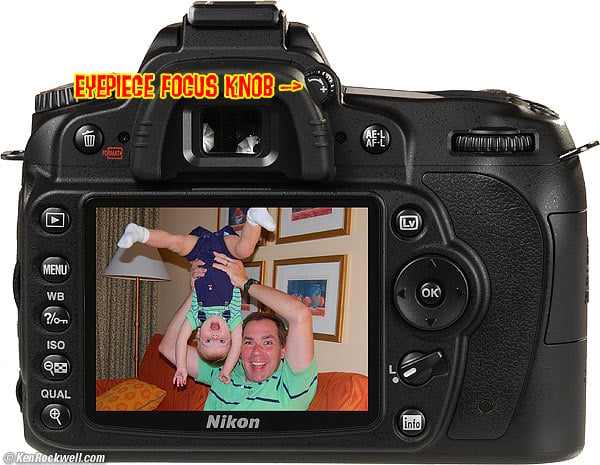
Nikon D90 eyepiece focus adjustment.
Eyepiece Focuser top
Twiddle the little ± knob, under the rubber just above the right of the eyepiece, until the finder is sharpest.
This is also called the dioptometic adjustment.
D90 AE-L/AF-L and rear dial.
AE-L/AF-L Button top
Hold this to lock exposure settings while shooting. You may change what this button does in the Custom Setting Menu f4.
I set mine to AEL.
Rear Dial top
Used to set just about everything in every mode.
D90 Live View button.
Live View button top
The Nikon D90 has the fastest and easiest to use Live View system of any camera I've used to date.
Press the button, and bingo, you're in Live View. Press it again and you're back to normal. You set the AF mode in Custom Settings Menu a7.
Want to make a movie? Just press the OK button while in Live View, and you're rolling. You set the movie parameters in the Shooting Menu.
Live View is so well designed that its easier to figure out by playing with it than for me to try to describe it in words. Have fun!
Nikon D90 Big Thumb Button.
Big Thumb Button top
This is used for everything: menu navigation, selecting AF areas, scrolling through playback images and a whole lot more.
You can configure the OK button in custom setting f2.
OK Button top
While playing back at normal size: Tap it to get to the Retouch menu.
While playing back with any sort of zoom in or out: Tap it to return to one image at normal size.
While in menus: Takes action on what you've set.
Nikon D90 Lock Lever
AF Selector Lock
This is an electronic lock.
It's smart: if set, it ignores the Big Thumb Button only while shooting. It doesn't lock anything else.
This is Nikon's best selector lock ever. It's almost impossible to knock by accident. The locks on Nikon's more expensive but older cameras, like the D1, D2, D3, F5 and F6, are easier to knock by accident.
Nikon D90 INFO Button.
The INFO Button
The Exposure Compensation button may be the most important button on any camera, but the new INFO button is the most fun.
Tap it, and finally you can see every adjustment on the rear LCD, where you need it!
Top LCDs are bogus, a leftover from film cameras because camera backs had to swing open to insert film. If the D90 is in your hand you can flip it to see the scrawny little top LCD, but you always can see the big, bright bold rear LCD in any light.
The INFO screen shows more than fits on the top LCD. For instance, the INFO display not only shows you the flash sync mode, it also shows you if the built-in flash is set to TTL, Manual, Repeating or to control remote flashes.
My year-old $5,000 Nikon D3, and the Nikon D300, are inferior because you need a second hand, and good timing, to hit a shared-purpose button on the left to get to the INFO screen.
On the D90, just hit the dedicated INFO button with your thumb and you're there at any time.
Hit INFO again and you can adjust the items along the bottom of the screen.
If you like, you also can call up the INFO screen by flipping the power/light button by setting this in Custom Function Menu f1.
My D90 User's Guide continues below.
I support my growing family through this website.
This guide is free to read online, but copyrighted and registered. If you haven't helped yet and would like to save or make a printed copy of this article for your camera bag, please send me $5.00 for each complete or partial copy that you print or save, for personal use only. Others charge $29.99 for crappier information, and with your honesty I can continue to offer these guides online for less.
If you bought your D90 by clicking through my links, then you've saved money and also helped me write this guide. Thank you and please enjoy it. It's great people like you, and those who help me otherwise, who allow me to keep adding to this site for everyone's benefit.
The biggest help is to use these links to Adorama, Amazon, B&H, Ritz and J&R when you get your goodies. It costs you nothing and is a huge help to me. These places have the best prices and service, which is why I've used them since before this website existed. I recommend them all personally.
Thanks for reading!
Ken
Back to Top of D90 User's Guide or Top of Nikon D90 Review
KNOBS and BUTTONS
MENUS
PLAYBACK < < NEXT
Home Donate New Search Gallery How-To Books Links Workshops About Contact
